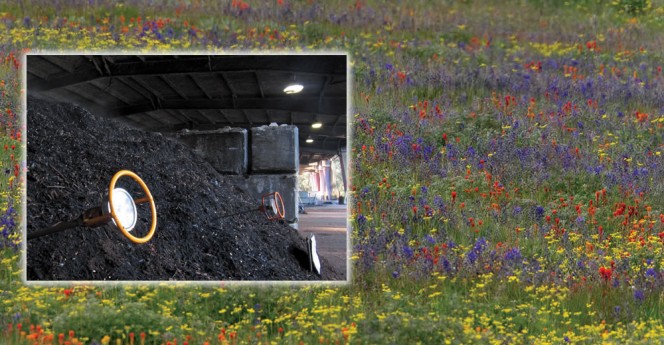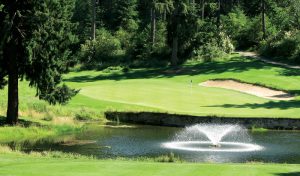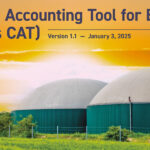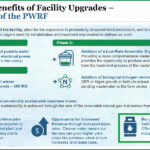Joint Base Lewis-McChord is using compost made from preconsumer food scraps on the base to restore habitat for several endangered species. Compost research at the base’s golf course also holds promise. Part II
Ashley Blazina
BioCycle July 2015

Applying compost made from the base’s food scraps and wood chips on prairie plots and scattering the larval and nectar host seeds led to spectacular growth. Photos by Aislin Gallagher and Rod Gilbert, JBLM
Joint Base Lewis-McChord in western Washington near the city of Tacoma began composting on-site in 2004, the same year the landfill on the base closed. The main driver was to help reduce the amount of waste that had to be transported off-base for disposal. Hence the Earthworks composting facility was born, sited atop part of the closed landfill. From the beginning, the Earthworks has composted preconsumer food scraps from facilities on the base with wood chips. Part I, “Military Base Steps Up To The Net Zero Challenge” (June 2015), describes JBLM’s source separated organics initiatives. This article focuses on the composting site, and use of the finished compost.
One of Earthwork’s original objectives was to develop a composting facility that was simple, prioritizing low costs and low maintenance. Its current aerated static pile system was designed by Peter Moon of O2 Compost with these main objectives in mind, and has enabled staff to expand and add on technology that minimizes manual labor.
In 2014, the facility composted close to 1,000 tons of food scraps, along with 290 tons of horse stable manure, 230 tons of leaves and grass, and 1,170 tons of wood chips. Wood waste is ground with a Rotochopper MP 2 and mixed in with the food scraps using a front-end loader. New compost piles are built in sections with aeration pipes running lengthwise beneath the ridge of the pile. Each pile has three perforated aeration pipes connected to a single blower. A layer of screened overs is placed on top of the pipe, preventing smaller particles from getting stuck inside the tubes. Al Ponton, the lead operator, places the premixed organics on top of the aeration pipes, then adds 12 inches of fine-screened wood chips on top as a biofilter to suppresses odors. The added layer also minimizes vectors, scavenging and retains heat and moisture.
Because the piles are not mixed once constructed, having the correct recipe and particle size in the initial mix is critical. Otherwise poor air distribution and uneven composting can occur. The wood chips help maintain good structure and porosity throughout the entire composting period. They are screened out at the end and recycled into a new pile, which inoculates the new material.
Two of the biggest timesaving investments made over the years are purchasing a front-end loader and installing concrete block bays. Before the front-loader, Ponton and two other staff members would manually build the piles, layering the piping and shoveling the organic wastes by hand. “Now, the only manual labor I have to do is rake out the wood chips when I’m building the pile,” explains Ponton, who is able to manage the entire composting operation by himself, greatly reducing operational costs.
Pile temperatures are monitored with electronic probes. Temperature data is sent throughout the day to Aislin Gallagher, an environmental scientist at Earthworks, who largely oversees the technical aspects of the composting operation. The data helps her catch problems before they arise. Real time monitoring also enables Gallagher to ensure the facility stays in compliance with time and temperature requirements that are part of JBLM’s permit to meet pathogen and vector attraction reduction.
Once those requirements have been met, the compost is moved to the curing area where it remains for a minimum of 30 days. After curing, compost is typically screened to half-inch size using a trommel. For special projects, e.g., golf course application, it is screened to three-eighth inch.. The finished compost is sampled quarterly to analyze the quality. Nutrient levels, metals, maturity/stability and pathogens are analyzed.
Gallagher notes that Earthworks hopes to continue expanding its reach in waste diversion at JBLM. Recent audits indicate that about 60 percent of preconsumer food scraps are still being thrown away. She also wants to modify the facility’s operational procedures to be able to accept increased volumes. “We are constantly updating our Compost Facility Plan of Operation,” explains Gallagher. “It’s a living document that reflects the dynamic nature of this business.”
Compost Success Stories
When JBLM first built Earthworks, most employees were focused on how composting could help increase landfill diversion rates and save more money, notes James Lee, manager of JBLM’s Qualified Recycling Program. What the base was going to do with the compost once it was cured was an afterthought.
After almost eight years of steady production, JBLM has developed a number of innovative uses for its compost — programs that are helping to recover threatened and endangered species and ecosystems along the way. The uses have been so successful that compost sales outside of JBLM have been officially suspended until further notice. Prairie restoration and compost use on the golf course are two of the most remarkable stories.
JBLM and Puget Sound Prairies
When most people think about the Pacific Northwest, they envision landscapes covered in giant evergreen forests. For the South Puget Sound region, however, this was not the case. Prior to Euro-American settlement in the middle of the 19th century, more than one million acres of prairie dominated this region. “Most of the towns in the South Sound are built on prairies because they were easily accessible and didn’t require cutting down old growth trees to build on,” explains Rod Gilbert, a JBLM biologist. “Today only about 5 percent of the original prairie expanse remains and most of that is, by default, on JBLM.”
He adds that prairies are an ecosystem that needs fire to survive. Without it, conifers and shrubs quickly encroach and alter prairie structure, making it too shady for prairie plants like Golden paintbrush to thrive. The one area that regularly had fires after the early settlers banned burning prairies was JBLM’s artillery range — artillery fires regularly ignited on the range, ironically helped the prairie maintain itself. Today the artillery range has some of the highest quality prairie that remains.
The recent listing of three prairie species on the Endangered Species List by the U.S. Fish and Wildlife Service requires JBLM to restore prairie habitat and increase populations of these three species on its property. The three listed species — Taylor’s Checkerspot Butterfly, the Mazama Pocket Gopher and the Streaked Horned Lark — all require slightly different habitat structure and plants to thrive. “For example, the Taylor’s Checkerspot requires specific host plants for larvae to eat,” says Gilbert. “Otherwise, they would starve.”
Unfortunately, seeding some of these butterfly host plants directly into the remaining prairies has had limited success. “When plants did germinate, they were often very small and didn’t provide sufficient available food” he explains. He had the idea of possibly developing small prairie plots on degraded habitat within current prairie that would have just larval and nectar host plants. This process would leave the current prairie intact. After clearing one experimental space of invasive weeds, Gilbert and his team covered the plots with Earthworks compost and scattered the larval and nectar host seeds — and the growth was spectacular. Gilbert knew the compost could be the answer.
Today, one of the main goals for Gilbert is to build a steady seed nursery where difficult-to-grow prairie plants like sea pink and blue-eyed Mary can be used to help restore prairies on JBLM. Located a short walk along a gravelly path away from Earthworks, a small valley of dark, rich earth surrounded by rolling green hills and small hardwood trees can be seen. The next step is to increase drainage, as previous development compacted the soil and has created an irrigation issue. If the drainage issue is resolved, additional seed beds will be established and overseen by the Center for Natural Lands Management, a locally-based nonprofit that specializes in restoring endangered habitats.
Eagle’s Pride Golf Course Turf Management
When Dave Wieneke, Superintendent of the Chambers Bay Golf Course in the South Puget Sound, first found out about using compost as a soil amendment for golf courses, it didn’t make sense to him. “A big problem for turf is the buildup of organic matter,” he notes. “It was counterintuitive to me that to counter organic matter, we would add organic matter.”

Research is being conducted at JBLM’s golf course to determine how much compost is needed as “foodstock” for soil microbiota to better control the amount of organic matter building up on the course. Photo by Dave Wienecke, JBLM
Wieneke, who has been working on golf courses throughout the Puget Sound since the 1970s, first discovered the powers of compost by accident while developing a new divet mix for a course. “When you mix sand with compost [compared to just sand], it increases the success of divet repair dramatically, because it holds nutrients with seed,” he says. “When you compare the two, the one with compost does twice or three times better than the one without.”
Wieneke, along with Nate Stacey and Andy Bary from Washington State University, have been conducting experiments at JBLM’s Eagle’s Pride Golf Course to examine how compost mixes fare on golfing greens. “The objective of this research is to examine golf course management on a holistic basis using compost as a nutrient and microbiological input to see how this affects the ultimate success of the golf course turf,” explains Bary, a longtime soil scientist. What they hope to discover is that by increasing the amount of “foodstock” for soil microbiota, they can better control the amount of organic matter building up on the course. If successful, the project could have huge ramifications for the course, and possibly golf course management worldwide. Wieneke notes that most divet mixes use sphagnum moss, a product that has to be mined from Canadian wetlands. With compost, divets no longer need sphagnum moss to retain moisture and the compost is recycling carbon.
Compost may also help with fertilizer needs, thereby eliminating the high costs of keeping the greens looking lush. “Compost offers a slow, constant release of nutrients, not the peaks that you would find with fertilizer,” adds Wieneke. “Turf doesn’t do well with the peaks of nutrients. With a constant release, there’s less leaching of nutrients as well.”
Wieneke, Bary and Casey are currently in Phase II of the experiment, and are assessing what the compost is doing on a micro level. After examining the microbial biomass, water retention, and various vegetative responses to the nutrients, the team hopes they’ll have research that can change the way golf courses are managed.
Social Change Through Action
To help reinforce the importance of sustainability in all aspects of JBLM operations — and to stay the course on its net zero journey — Joint Base Lewis-McChord’s current Commanding Officer, Colonel H. Charles Hodges, stars in sustainability public service announcements (PSAs), spoofing everything from top blockbusters to TV shows. He has donned a pair of brightgreen tights and a pointed hat (a la the movie, “Elf”), and spoofed the infamous “Apocalypse Now” line with, “I love the smell of compost in the morning.” All PSAs play as movie previews at the base’s cinema and are offered via streaming online. “I’m losing my dignity while making these PSAs, but it’s getting people to talk,” notes Hodges. “It’s changing the mindset.”
In addition to inspiring a younger generation to develop composting and recycling habits as a part of life, Hodges also recognizes how much these steps have prompted monetary benefits. “It costs about $30,000 to turn the lights on at the base every day,” he explains. “Sustainability saves money. Morale, welfare and recreation programs are largely funded through the recycling program. We see a lot of bases that have had to limit their recreation programs. Through our savings, we’ve never had to.”
With many military bases being ground zero for testing out new technologies and innovative ideas, Joint Base Lewis-McChord has become an icon of a sustainable community. In less than a decade, it’s developed programs that have diverted thousands of tons of waste, saved endangered species and inspired a younger generation to live more sustainably — all for a lower price tag.
Corrections: July 23, 2015
• 2014 food scraps composted corrected to 1,000 tons. Volume data for manure and yard trimmings added.
• Screening size details added.













